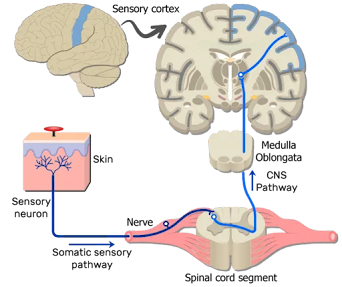For instance, you're at the playground and you get sand in your eyes. How do you know the sand is there? You obviously can't see it, but if you are a normal healthy human, you can feel that the sensation of extreme discomfort, also known as pain. Now, pain makes you do something, in this case, rinse your eyes until the sand is gone. How do you know the sand is gone? Exactly, because there's no more pain.
There are persons who are unaffected by pain. That may appear to be cool, but it isn't. If you can't feel pain, you may unintentionally injure yourself or others. Your body's early warning system is pain. It shields you from the outside world as well as from yourself. Pain detectors are installed in most places of our bodies as we grow. These detectors are nociceptors, which are specialized nerve cells that run from your spinal cord to your skin, muscles, joints, teeth, and some internal organs.
 |
| Working mechanism of pain relievers, Image credits: getbodysmart.com |
They conduct electrical signals, just like all nerve cells and send information back to your brain from wherever they are. Unlike other nerve cells, however, nociceptors only activate when something occurs that has the potential to cause or is causing injury.
This is where over-the-counter painkillers come into play. Aspirin and ibuprofen inhibit the formation of prostaglandins, a type of tuning molecule. Let's look at how they accomplish this. When cells are injured, a substance called arachidonic acid is released. COX-1 and COX-2 are enzymes that convert arachidonic acid into prostaglandin H2, which is then turned into a variety of other chemicals that raise your body temperature, promote inflammation, and reduce your pain threshold.
Every enzyme now has an active site. The reaction takes place in this part of the enzyme. COX-1 and COX-2 active sites are particularly compatible with arachidonic acid. As you can see, there isn't much room left. Aspirin and ibuprofen now perform their functions in this active location. As a result, they work in distinct ways. Aspirin has the same impact as the spine of a porcupine. It enters the active site and then breaks apart, leaving half of itself in the channel, blocking it entirely and preventing arachidonic acid from fitting. As a result, COX-1 and COX-2 are irreversibly deactivated. Ibuprofen, on the other side, penetrates the active site without causing the enzyme to break down or alter. COX-1 and COX-2 are free to spit it out again, but the enzyme is unable to bind arachidonic acid and perform its regular chemistry when ibuprofen is present.
But how do aspirin and ibuprofen know where the pain is?
The medicines are conveyed throughout your body once they are in your bloodstream, and they reach painful areas in the same way they do normal ones. Aspirin and ibuprofen function in the same way. There are, however, other aspects to pain. Neuropathic pain, for example, is pain that is generated by injury to our neurological system without the requirement for an external trigger. In addition, scientists are learning that the brain is in charge of how we respond to pain signals. For example, how much pain you experience can be influenced by whether or not you're paying attention to it, as well as your mood.
Read more
https://amritgotame.com.np/platypuses-have-venom-releasing-spikes/
Comments
Post a Comment